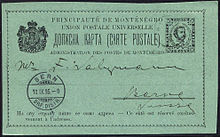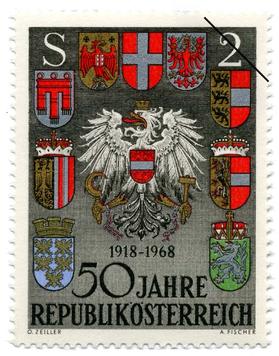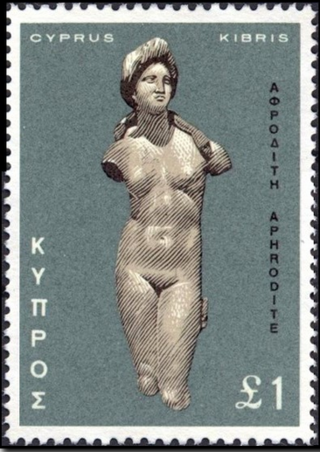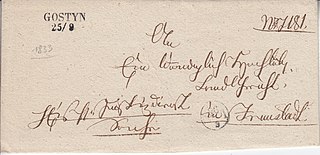You can help expand this article with text translated from the corresponding article in Russian. (February 2015)Click [show] for important translation instructions.
|

This is a survey of the postage stamps and postal history of Montenegro .
You can help expand this article with text translated from the corresponding article in Russian. (February 2015)Click [show] for important translation instructions.
|

This is a survey of the postage stamps and postal history of Montenegro .

During the first part of the 19th century private letters from Montenegro are very rare. It is mainly official and ecclesiastical letters carried by couriers that are to be found. [1]
In 1854 an Austrian Post Office, operated by Österreichischer Lloyd, was opened in Antivari, then in the Ottoman Empire, now known as Bar; this office was closed in 1878 when the town was returned to Montenegro. The stamps used during this period were the issues for Austrian post offices in the Ottoman Empire. [2]
The first stamps to be issued by Montenegro were in 1874 which coincided with the opening of the first post office for public use. [1] The design of the stamps had a bust of Prince Nicholas.
In 1893 seven different values of the existing stamps were overprinted to commemorate the 400th Anniversary of introduction of printing into Montenegro. In 1896 a range of 12 stamps were issued for the bicentenary of the Petrović-Njegoš dynasty. 1902 saw the introduction of new currency and new stamps with a new design and a new bust of Prince Nicholas.
Montenegro was one of the few European countries to issue a stamp for the Avis de réception service. [3]
In 1905 a new Constitution was passed in Montenegro and this resulted in existing stamps being overprinted to commemorate the event. Another change in currency in 1907 produced new stamps with another design incorporating the bust of Prince Nicholas.
On the 50th anniversary of the reign of Prince Nicholas, in 1910, he was crowned King of Montenegro and the principality was proclaimed a kingdom. [4] This resulted in a new range of stamps being issued to commemorate this event.
In 1912 a new set of definitive stamps incorporating the bust of King Nicholas was issued.
Austria-Hungary occupied Montenegro in 1915. Austro-Hungarian military stamps were overprinted Montenegro and issued in 1917. Only 2 stamps were officially issued by Austria-hungary during World War I on 1 March 1917: 10 heller and 15 heller Feldpostmarken with a double vertical overprint K.u.K. Milit.-Verwaltung Montenegro. [5] The general public, however, used stamps of Austria during the occupation.[ citation needed ]
Stamps with horizontal Montenegro overprint are not official nicht verausgabte, and were printed for the first anniversary of Austrian troops occupation [6]
On 13 November 1918 Montenegro was united with Serbia. In 1922 it became part of the Kingdom of Serbs, Croats and Slovenes. Then in 1929 this became the Kingdom of Yugoslavia.
Montenegro was occupied by Italy in 1941. The Protectorate of Montenegro was established and issued stamps until 1943. After the withdrawal of Italy from the war, the territory of Montenegro was occupied by Germany in September 1943.
In April 1941, Kotor and the adjacent territories of the Montenegrin coast were annexed and incorporated into Italy as the Province of Cattaro of the Governorate of Dalmatia. After Italy surrendered to the Allies, the territory of the province of Cattaro was occupied by German troops in September 1943. Stamps were issued under the German military administration for Kotor in 1944.
After 1944 Montenegro became part of the federal republic of Yugoslavia and then the Union of Serbia and Montenegro in 2003.
Stamps for Montenegro again resumed issuing in 2005. Montenegro declared independence on 3 June 2006.

The postal stationery issued by Montenegro used the same designs as those used for stamps.
Postcards were first issued in 1888, envelopes and newspaper wrappers in 1893, and lettercards in 1894. The design of all these was the bust of Prince Nicholas as first used for stamps in 1874. [7]
In 1893, only envelopes and postcards were overprinted to commemorate the 400th anniversary of introduction of printing into Montenegro.
In 1896 all the different items of stationery were issued for 200th anniversary of Petrovich Niegush Dynasty.
The 1902 new stamp design of the bust of Prince Nicholas was also employed on all the items of postal stationery.
In 1906, envelopes, lettercards and postcards were overprinted to commemorate the granting of the constitution.
The 1907 and 1912 (in 1913) stamp designs were also used on all four items of postal stationery.

An overprint is an additional layer of text or graphics added to the face of a postage or revenue stamp, postal stationery, banknote or ticket after it has been printed. Post offices most often use overprints for internal administrative purposes such as accounting but they are also employed in public mail. Well-recognized varieties include commemorative overprints which are produced for their public appeal and command significant interest in the field of philately.

This article deals with the stamps and postal history of the Austrian Empire, Cisleithania within Austria-Hungary, and the Republic of Austria.

Petar II Petrović-Njegoš, commonly referred to simply as Njegoš (Његош), was a Prince-Bishop (vladika) of Montenegro, poet and philosopher whose works are widely considered some of the most important in Montenegrin and Serbian literature.

Austria and other European nations maintained an extensive system of post offices in the Ottoman Empire, typically motivated by the unreliable postal system of the Ottomans.

This is an overview of the postage stamps and postal history of Australia.
This is a survey of the postage stamps and postal history of British East Africa.

The British Central Africa Protectorate existed in the area of present-day Malawi between 1891 and 1907.
This article provides an overview of the Austrian post-offices presence in Crete and the use of French currency on Austrian stamps in the Ottoman Empire.

Lovćen is a mountain and national park in southwestern Montenegro. It is the inspiration behind the names Montenegro and Crna Gora, both of which mean "Black Mountain" and refer to the appearance of Mount Lovćen when covered in dense forests. The name Crna Gora was first mentioned in a charter issued by Stefan Milutin in 1276 and was used for several regions across medieval Serbian lands, including Skopska Crna Gora and Užička Crna Gora.

The perper was the currency of Montenegro between 1906 and 1918. Named after the Byzantine hyperpyron, it was divided into 100 para.

Prince Michael Petrović-Njegoš of Montenegro was the third son of Prince Mirko of Montenegro, Grand Voivode of Grahovo and Zeta (1879–1918), and Natalija Konstantinović, a cousin of Aleksandar Obrenović of Serbia. He was pretender to the throne of Montenegro, holding the title Grand Duke of Grahovo and Zeta, in succession to his father. King Nicholas I of Montenegro was Michael's grandfather. Michael had recognized and acknowledged the Unification of Montenegro with Serbia, renouncing the throne. In World War II he was held prisoner by the Nazis after refusing to take up the throne of the Axis forces' re-established Montenegrin puppet-state. During the period of Yugoslav socialism, he was an active member of the Serb diaspora revolutionary organization and a diplomatic worker against the socialist government led by Marshal Tito.

The culture of Montenegro is as pluralistic and diverse as its history and geographical position would suggest. Montenegro's culture has been influenced by the Serbian Empire, the Byzantine Empire, ancient Greece, ancient Rome, Christianity, the Ottoman Empire, the Republic of Venice, Austria-Hungary, and Yugoslavia.

The story of the postage stamps and postal history of Yugoslavia officially begins with the formation of the Kingdom of Serbs, Croats and Slovenes on 1 December 1918.
This is a survey of the postage stamps and postal history of Algeria.

The postal history of Turkey and its predecessor state, the Ottoman Empire, dates to the 18th century when foreign countries maintained courier services through their consular offices in the Empire. Although delayed in the development of its own postal service, in 1863 the Ottoman Empire became the second independent country in Asia to issue adhesive postage stamps, and in 1875, it became a founding member of the General Postal Union, soon to become the Universal Postal Union. The Ottoman Empire became the Republic of Turkey in 1923, and in the following years, its postal service became more modernized and efficient and its postage stamps expertly designed and manufactured.

This is a survey of the postage stamps and postal history of Cyprus. The country's postal history is intricately linked to the island's political past.
This is a survey of the postage stamps and postal history of British Bechuanaland.

Poczta Polska, the Polish postal service, was founded in 1558 and postal markings were first introduced in 1764. The three partitions of Poland in 1772, 1793 and 1795 saw the independent nation of Poland disappear. The postal services in the areas occupied by Germany and Austria were absorbed into those countries' postal services. In 1772 the area occupied by Austria was created into the Kingdom of Galicia, a part of the Austrian Empire. This lasted till 1918. The Duchy of Warsaw was created briefly, between 1807 and 1813, by Napoleon I of France, from Polish lands ceded by the Kingdom of Prussia under the terms of the Treaties of Tilsit. In 1815, following Napoleons' defeat in 1813, the Congress of Vienna, created Congress Poland out of the Duchy of Warsaw and also established the Free City of Kraków. Congress Poland was placed under the control of Russia and the postal service was given autonomy in 1815. In 1851 the postal service was put under the control of the Russian post office department regional office in St Petersburg. In 1855 control was restored for a while to the Congress Kingdom but following the uprising in 1863 again came under Russian control from 1866 and continued until World War I. In November 1918 the Second Polish Republic was created.

This is a survey of the postage stamps and postal history of Slovenia.

Grlica was the first serial publication published in Montenegro. It was published from 1835 to 1839 in Cetinje, and was largely edited by Dimitrije Milaković, personal secretary of Prince-Bishop Petar II Petrović-Njegoš. It served as both a calendar, as well as an almanach, and was primarily aimed at the youth. Heavily influenced by Romanticism, Grlica was similar in content and purpose to Vuk Karadžić's Danica and ideas of Pan-Slavism and Yugoslavism were common themes.